This site is made possible by its sponsors.
Please visit them!
PMS - See Pantone Matching System (PMS).
pneumosparklyosis - A fictitious ailment also known as glitter lung.
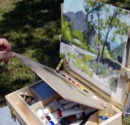
pochade - A small color sketch, usually in oil paint. A pochade is often a rough little landscape, typically produced away from the studio, with the intention of referring to it later in the studio in order to paint a larger, more developed version. A pochade box is a sketch box, a very portable container for carrying oil-painting supplies on field trips. This is a French word used by English speakers.
(pr. poh-SHAHD)
Also see alla prima, plein air, and underpainting.
pochoir - A print made from stencils. It was often used for the reproduction of original color works. It was used in France by the most prominent artists and craftsmen to produce illustrated deluxe portfolios, books, limited-edition journals, and decorative and fine-art prints between 1895 and 1935.
(pr. poh-SHWAHR)
Examples:

Auguste H. Thomas (French, n.d.), author;
Paris: A. Levy, Librarie Centrale des Beaux-Arts, publisher,
Plate 1 , floral and animal motifs, from
Formes et Couleurs : Vingt Planches en Couleurs Contenant
Soixante-sept Motifs Decoratifs, 1921, printed book with
twenty pochoir plates, height 47 cm, Metropolitan Museum of Art,
NY.
.jpg)
Henri Matisse (French, 1869-1954), Icarus, 1947, color pochoir, 16 1/2 x
10 1/2 inches (image) 16 1/2 x 25.2 inches (sheet), Metropolitan
Museum of Art, NY. This is among the
twenty pictures produced by Henri Matisse for his book Jazz.
See cutout.
Also see cutout and serigraphy.
point - While it usually refers to a specific location, to a sculptor, a point is a simple metal tool with a pointed end used to rough out (dress) the basic shape of a stone carving. Hammered vertically and with force at the stone face, it not only punctures the stone's surface but causes a rough circle of stone to burst off around this puncture. Handled softly it can gradually reduce the surface, giving it an overall crumbly or pulverized appearance. A fine punch can also be driven into the stone as a defining hole. In addition, the point can be used obliquely to score the stone in long jagged lines. In typography, it is the smallest unit of measurement: although actually .01384 inch, for practical purposes, it is 1/12 of an inch, and twelve points equal one pica.
Also see aculeate, angle, blot, calcagnolo, claw chisel, concentric, dot, period, pied de biche, pointing machine, tangent, and vertex.
pointillism - A method of painting
developed in France in the 1880s in which tiny 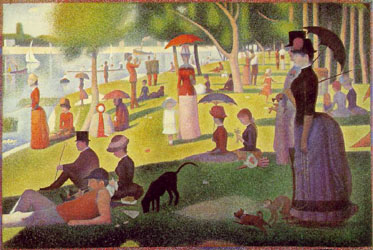 dots
of color are applied to the canvas.
When viewed from a distance, the points
of color appear to blend together to make other colors and to
form shapes
and outlines. Georges Seurat (French, 1859-1891) was its leading
exponent. His most famous painting is
dots
of color are applied to the canvas.
When viewed from a distance, the points
of color appear to blend together to make other colors and to
form shapes
and outlines. Georges Seurat (French, 1859-1891) was its leading
exponent. His most famous painting is A
Sunday Afternoon on the Island of La Grande Jatte (Un dimanche
après-midi à l'Ile de la Grande Jatte), 1884-1886, oil on canvas, 81 x 120 inches,
Art Institute of Chicago. Occasionally used synonyms for pointillism
have been "divisionism" and "confetti-ism."
See other examples at Neo-Impressionism.
Also see brindled, optical mixing, pattern, piebald, Segantini stitch, stipple, and variegated.
pointing and pointing machine - A mechanical means of indirect carving —reproducing or scaling up a three-dimensional form in correct proportion. A pointing machine is a framework of metal arms which can be fitted around a sculpture to measure the relationship between given points on its surface. A pointing machine permits these measurements to be transferred from a model to another mass of material — usually a block — the block then cut into either by hand or by machine. Pointing machines are especially necessary for the carving of sculptures having complex form which is based on a plastic model. Greek and Roman sculptors are known to have used them. They were re-invented during the Italian Renaissance. Further improvements made during the eighteenth and nineteenth centuries included pantographic devices which allowed small models to be scaled up. The pantograph is a similar device for copying two-dimensional figures.
Related link:
Also see caliper, full-scale, and piece mold.
point of view - A position or angle from which something is observed or considered, and the direction of the viewer's gaze; a standpoint which is either a physical location or one in the mind. Examples of the points of view possible in a picture are: from below, from inside, from outside, from above, and so on. A manner of viewing things; an attitude. The attitude or outlook of a narrator or character in a piece of literature, a movie, or another art form. In discussing art, to use the common synonym "perspective" may be confusing.
Examples of points of view:

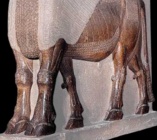
Mesopotamia, Palace of King Ashurnasirpal II of Assyria, Nimrud, entrance to the east suite, One of a Pair of Lamassu, c. 875 BCE, carved stone, British Museum, London. However it is displayed in a museum, in its original context, a lamassu is the guardian of a doorway, integral with a wall. For this reason, it is not an entirely freestanding sculpture. It was carved as if it were two reliefs joined at right angles. These guys always have five legs, because that's the way lamassu can present the correct number of legs when seen from each of the two points of view implied by two relief sculptures — two legs when seen from the front, and four when seen from the side. See a larger detail of the legs. Additionally, the side view shows legs in motion, whild the frontal view shows the creature at rest. See Mesopotamian art.

Discus Thrower (Discobolus), Roman copy
of an original bronze
by Myron (Hellenistic Greek, c. 485 - c.
425 BCE),
marble. In viewing two-
and three-dimensional works
 of art, it is particularly important to see a freestanding sculpture from more than one point of view.
of art, it is particularly important to see a freestanding sculpture from more than one point of view.
A second point of view on
the Discus Thrower.
![]()

![]()
Diego
Velázquez (Diego Rodríguez de Silva y Velázquez)
(Spanish, 1599-1660), The
Family of Philip IV, or "The Maids of Honor (Las Meninas)", c. 1656, oil
on canvas, (318 x 276 cm),
Prado Museum, Madrid.
 This
is a group portrait
of an exceptional sort:
This
is a group portrait
of an exceptional sort:
In the center-foreground
is the infanta (princess) attended by her meninas (maids of honor)
—
![]()
 companions
including two young ladies, a dwarf, a child, a dog, a nun, and
a tutor.
companions
including two young ladies, a dwarf, a child, a dog, a nun, and
a tutor.
This little party is visiting the studio
where Velázquez stands before his canvas. We see the back of it, perched upon
an easel. The
 painter
and most of the others look toward the king and queen as they
pose for the painting in progress.
painter
and most of the others look toward the king and queen as they
pose for the painting in progress.
The king and queen would not actually be
visible in this picture if their reflected
image could not be seen in a mirror
placed on the opposite wall. Altogether this is a view that
could only be seen by the king and queen themselves, as they
pose for their portrait. The point of view of every person who
gazes upon this painting is
that of the king and queen of Spain -- a very privileged vantage
indeed! See Baroque,
genre, self-portrait, and Spanish
art.
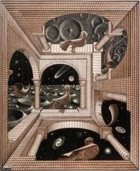
Maurits
Cornelis Escher (Dutch, 1898-1972), Other World, 1947, color wood
engraving and woodcut
printed from three blocks in black, red-brown, and green; image 12 1/2 x 10 1/4
inches (31.8 x 26.1 cm), sheet 39.2 x 32.9 cm; Fine Arts Museums
of San Francisco, CA. Depending upon which of this room's three
windows we look out, we find our point of view is completely
different — entirely inconsistent
with each of the others! See optical
illusion.
And about point of view:
Also see aerial or bird's-eye view, anamorphosis, attitude, bias, di sotto in sù, fish-eye lens, focal point, herringbone perspective, irony, linear perspective, obsession, panorama, propaganda, refraction, telephoto, wide-angle, and worm's-eye view.
poison - Any substance capable of causing injury or death.
When someone has been exposed to toxic
substances, immediately contact a poison control center network
or get medical assistance — telephone 911 in many communities.
Many manufactured
art and craft
materials carry a label stating "Conforms to ASTM D-4236."
This indicates that the product conforms to the labeling standards
of the Hazardous Art Materials Act (HAMA), which was signed into
US law on November 18, 1988. If the product is non-toxic, then
no warning needs to be included on the label. However, if the
product is found to carry acute or chronic health hazards, the
information on the label must alert the consumer to those hazards.
The part of this law which is of greatest importance here is the
Labeling of Hazardous Art Materials Act (LHAMA). The law requires
art material labels to (a) carry a warning statement identifying
chronic health hazards, (b) list the ingredients causing those
hazards, and (c) provide directions for safe use of the product.
The phrase, "Conforms to ASTM D 4236", is required as
evidence that the guidelines of the standard were followed in
the labeling of the product. The evaluation is to be conducted
by a board-certified toxicologist, and the product must be reevaluated
periodically, at least every five years. Another key piece of
information to be found on the label, as directed by the standard,
is a source for additional information. This can take the form
of a toll free phone number that is reachable 24 hours per day,
or directions to contact a poison control center network. Under
the Labeling of Hazardous Art Materials Act, it became a requirement
for chronically hazardous products to carry the phone number of
a person responsible for placing the product on the market. The Consumer
Product Safety Commission (CPSC) is the US's federal agency
charged with enforcing HAMA.
(pr. POY-zən)
Also see Art & Creative Materials Institute (ACMI), ASTM International (American Society for Testing and Materials), caustic, ergonomics, flammable, fumigation, hazardous, Material Safety Data Sheet (MSDS), preparator, solvent, toxic, and volatile.
polarizing - In photography, using a "polarizing" filter to limit the normal pattern of lightwaves.
Also see direction, light, moiré, and straight.
polish - To impart a very smooth finish to a surface, or such a finish itself. Also, the material which can be used to produce such a finish, either by rubbing with a mild abrasive or by the action of chemicals. Examples of such materials include: tripoli, rottenstone, pumice, and rouge.
(pr. PAH-ləsh)
Quote:
Also see flat, glare, glossy, matt, mirror, rouge paper, semi-gloss, and semi-matt.
political correctness, politically correct, and PC - Developed in the mass media, these terms came into use in the 1980s to describe those who seek a social transformation in various ways: challenging the canon to which the traditional curriculum had adhered (demanding the inclusion of studies of non-mainstream cultures), traditional notions of identity (race, gender, class, and sexuality), as well as sensitivity to unconscious racism and sexism and to environmental concerns. The momentum of this movement came largely from the political left, and from intense debates taking place on college and university campuses. Although there is no defensible ground on which to disagree with its spirit, this movement has been derided as a form of thought-police — for its demands of adherence to a party line.
Quote:
Also see ethnocentrism, feminism and feminist art, gender issues, heterodox, multiculturalism, orthodox, pluralism, xenophilia, transgressive art, and xenophobia.
polychrome - Having many colors; multicolored. This term is usually used to describe sculptural or decorative objects finished or decorated with paint or glazes.
Examples of such works are:

Greece, Figurine of Aphrodite Playing with Eros,
tanagra, late 4th century
BCE,
polychromed terra
cotta, height 18.5 cm,
State Hermitage Museum, St. Petersburg, Russia. This sculpture
of Aphrodite is amusing Eros with a spinning top illustrates
a tendency towards genre sculpture which was characteristic of
Hellenistic art. See mythology.

Michelangelo Buonarroti (Italian, 1475-1564),
Crucifix,
1492-94, wood, painted, height
53 inches (135 cm), Casa Buonarroti, Florence. See Renaissance.
Italy, Naples, c 1600, Archangel Raphael, polychromed and gilt wood, height 70 inches (177.8 cm), Los Angeles County Museum of Art.
![]()
Luisa Roldán (Spanish, 1650-1704),
sculptor; Luis Antonio de los Arcos, polychromer, gilder, St. Ginés de la Jara, about 1692,
polychromed wood (pine and cedar)
with glass eyes, height
69 1/4 inches (176 cm), J. Paul Getty Museum, Malibu, CA. See
gild.
Pierre-Auguste Renoir (French, 1841-1919), Bust of Madame Renoir, 1916, polychromed cement, Musée d'Orsay, Paris.

Nancy Graves (American, 1940-1995), Immovable Iconography, 1990, aluminum,
bronze, brass, with polychrome
patina and paint,
24 x 22 x 12 inches, Kemper Museum of Contemporary Art, Kansas
City, MO.
Also see incrustation, moiré, and statue.
polyester resins - Synthetic plastic resin in liquid form are made to solidify by the addition of a catalyst. Resin, reinforced with glass fiber, is commonly used as casting material, but may also be modeled when thickened with an inert filler such as powdered chalk. It can be cut and abraded when hard.
Polyester is also a common name for the plastic polyethylene terephthalate. Its characteristics include transparency, colorlessness, and high tensile strength. In addition, it is useful in art conservation because it is very chemically inert. Commonly used in sheet or film form to make folders, encapsulations and book jackets. Its thickness is often measured in mils. There are several common trade names.
trademarks for polyesters
|
trade name |
manufacturer, country |
| Beetle ® (resin) | BIP, UK |
| Crystic ® (resin) | Scott-Bader, UK |
| Dacron ® (fiber) | Du Pont, UK and USA |
| Gel Cote ® | Glidden International, USA |
| Hetron ® (resin) | Durax, USA |
| Melinex ® (film) | ICI, UK |
| Mylar ® (film) | Du Pont, USA |
| Plaskon ® (resin) | Allied Chemicals, USA |
| Terylene ® (fiber) | ICI, UK |
Also see fiberglass and trademark (®).
polyethylene - A chemically inert, highly flexible, transparent or translucent plastic. Used in art conservation to make sleeves for photographic materials, among other uses.
Also see polypropylene.
polygon - A closed plane
figure (shape)
bounded by three or more straight-line segments. A list of names
of polygons, and the formulae for finding their areas when their
sides are equilateral :
| 3 | triangle | 0.433 s squared |
| 4 | square | s squared |
| 5 | pentagon | 1.7205 s squared |
| 6 | hexagon | 2.5981 s squared |
| 7 | heptagon | 3.6339 s squared |
| 8 | octagon | 4.8284 s squared |
| 9 | nonagon | 6.1818 s squared |
| 10 | decagon | 7.6942 s squared |
| 11 | undecagon | 9.3656 s squared |
| 12 | dodecagon | 11.1961 s squared |
Other 4-sided polygons are the parallelogram (can be equilateral or non-equilateral), quadrilateral (sides can be of any lengths), rectangle (non-equilateral), and rhombus (non-equilateral), trapezium, and trapezoid (non-equilateral).
Also see circle, mathematics, polyhedron, radial, regular, vertex, and wireframe.
polyhedron - A three-dimensional figure bounded by polygons. Each of its sides is called a face. Each of the straight lines which describe the meeting of faces is called an edge, and each point at the end of an edge is called a vertex. The plural form can be either polyhedrons or polyhedra.
Polyhedra are among the ten classes of patterns.
Art employing polyhedra:
Fra Giovanni da Verona (Italian), three panels of wood intarsia, 1520: Each conveys the appearance of open cupboard doors -- a trompe l'oeil effect resulting from the use of linear perspective. The first panel: a Campanus sphere, a mazzocchio, and various instruments of the geometer. The second panel: a complex polyhedron which can be constructed by erecting a pyramid of equilateral triangles on each face of an icosidodecahedron. The third: the Campanus sphere again, along with an icosahedron and a truncated icosahedron.
Types of polyhedra:
| 4 | tetrahedron |
|---|---|
| 4-infinity | pyramid |
| 5-infinity | prismatoid |
| 6 | hexahedron |
| 6 | cube |
| 6 | rhombohedron |
| 6 | parallelepiped |
| 7 | heptahedron |
| 8 | octahedron |
| 10 | decahedron |
| 12 | dodecahedron |
| 20 | icosahedron |
Example use of polyhedra:
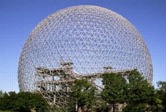
R. Buckminster Fuller (American, 1895-1983)
architect, Geodesic Dome, 1967, on the site of the 1967
World's Fair, during which this dome
housed the United States Pavilion. Location: l'Ile-Ste-Hélène,
Montreal, Canada. About 300,000 such structures
of various sizes are now scattered throughout the world, most
such polyhedrons were built in the
1960s when interest in them was at its peak.
Also see mathematics, regular, sphere, and straight.
polymer - A chemical compound made by grouping molecules to form natural or synthetic resins. Acrylic resins are polymers in a thermoplastic or thermosetting form of either acrylic acid, methacrylic acid, esters of these acids, or acrylonitrile, and are used to produce paints, and such lightweight plastics and synthetic rubbers as nylon. Polymer clay, polyurethane, and other materials are made of polymers.
An example of a painting made with polymer colors:

Frank Stella (American, 1936-), Raqqa II, 1970, synthetic polymer and graphite on canvas, 120 x 300 inches (304.8 x 762 cm), North Carolina Art Museum, Raleigh. See Minimalism and protractor.
polymer clay - A modeling material consisting of finely ground particles of colored polymer, often polyvinyl chloride (PVC), held together by a binder to form a malleable clay-like medium. Trademarked brand names include FIMO and Sculpey. In oven-fired polymer clays, finished articles are heated in a domestic oven to fire or fuse or sinter the polymer molecules into a hard, durable object — often jewelry, beads, or small sculptures. Because polymer clays are made of self-colored molecules, making them bleed-proof: different colors do not bleed into each other when placed against each other.
Baking any art material in an oven also
used for food carries the risk of contaminating food. Use a separate
oven that has reliable temperature control and only bake polymer
clays to the manufacturer's recommended hardening temperature.
Obtain the Material Safety Data
Sheet (MSDS) from the manufacturer or supplier, and make sure
the temperature of decomposition is not reached. Do not use hardening
modeling clays that have DEHP as a plasticizer, because, at this
time (2004), the longterm hazards of replacement plasticizers
have not been adequately researched. Use polymer clays either
outdoors or in front of a window exhaust fan.
Also see modeling clay and modeling tools.
polyptych - An artwork such as an altarpiece made up of more than three panels or sections, often hinged. A four-paneled one is a quadriptych.
A two-paneled artwork is a diptych. A three-paneled one is a triptych.
(pr. POHL-ip-tək)
Example:
![]()
![]()
Byzantine, 14th century, Hexaptych Icon with Scenes from the Great Feasts
(obverse), Apostles, Saints, and Angels (reverse),
tempera and gold on six wood
panels, 31 x 13.5 cm (12 1/4 x 5 3/8
inches) each panel, Holy Monastery of Saint Catherine, Sinai,
Egypt. The "hex-" in hexaptych signifies "six."
See Byzantine
art.
polyropylene - A plastic material highly suitable for the acid-free archival storage of works on paper and other small two-dimensional object.
trademarks for polypropylene
|
trade name |
manufacturer, country |
| Propafilm ® | ICI, UK |
| Propathene ® | ICI, UK |
| Propylex ® | British Celanese, UK |
| Vulkide B ® | ICI, UK |
Examples:

Transparent
polypropylene sheet and photograph
protectors, each with pockets of various sizes,
the sides and bottom of which are welded allowing top insertion.
Each is c. 9 x 11 inches, three-hole-punched for use in three-ring
binders, and is free of polyvinyl chloride
(PVC) and plasticizers for safe, long-term storage of photographic
slides, negatives,
prints, and other works
on paper. Over time, polypropylene is less likely to yellow, crack or tear than other
materials.

Synthetic Industries, company design and manufacture, Chattanooga, TN, Pyramat Erosion Mat, 1992, polypropylene, 78 x 120 x 1/2 inches (198.1 x 304.8 x 1.3 cm), Museum of Modern Art, NY.
Also see bin, collect, deltiologist, ephemera, exonumia, frame, memorabilia, philately, polyester resins, polyethylene, polymer, polystyrene, polyvinyl acetate, polyvinyl alcohol, polyvinyl chloride (PVC), portfolio, scripophily, solander box, and trademark (®).
polysemy - Many meanings. From the Greek for "many signs."
(pr. pə-LI-sə-mee)
Also see ambiguity.
polystyrene - A plastic which is available in several forms: Toughened polystyrene is a rigid plastic in sheet or board form. Foam core or foam board is a strong, stiff, resilient, and lightweight board of polystyrene laminated with paper on both of its sides. Expanded polystyrene is a lightweight, granular mass, usually worked in sheets or blocks, but also available in loose granules.
(pr. PAH-lee-STI:-reen)
Example:

Rachel Whiteread (English, 1963-) Untitled
(Yellow Bath), 1996, rubber and polystyrene, Carnegie
Museum of Art, Pittsburgh, PA. See sculpture.
trademarks for polystyrene
|
trade name |
manufacturer, country |
| Bexfoam ® (expanded) | BXL, UK |
| Bextrene ® | BXL, UK |
| Carinex ® | Shell, UK |
| Catalin ® | Catalin Corp., USA |
| Erinoid ® | Erinoid Ltd., UK |
| Fostarene ® | Foster Grant Co., USA |
| Styrocell ® (expanded) | Shell, UK |
| Styrofoam ® (expanded) | Dow Chemicals, USA |
| Styron ® | Dow Chemicals, USA |
Related link:
Also see foam core, nylon, polyester resins, polymer, polypropylene, polyvinyl acetate, polyvinyl alcohol, polyvinyl chloride (PVC), and trademark (®).
polyurethane - Any of various thermoplastic polymers that contain urethane. Polyurethanes can vary widely in their flexibility and rigidity — eraser-soft to bowling-ball-hard. They are typically used in resins, chemical-resistant coatings, elastomers, adhesives, fibers, and foams for padding and insulation. Polyurethanes can be obtained in cast sheets, bars, rods, and tubes, as well as in liquid forms in both water and oil-based formulas.
Urethane is a crystalline compound that is used especially as a solvent, and as the basis for polyurethanes. "Urethane" and "polyurethane" are terms that tend to be used interchangeably to refer to the same set of materials.
Based on their cost and physical properties — their load-bearing capacity, as well as weather, abrasion, impact, wear and tear resistance — polyurethanes have much to recommend them as alternatives to rubber, plastic, wood, metal, and other materials, in applications that have traditionally been filled by such materials, as proven by polyurethane's many uses in industrial situations.
Example:

Claes Oldenburg and Coosje van Bruggen (Dutch-American,
1942-), Stake Hitch, 1984, aluminum,
steel and urethane
foam, 642 x 182 x 534 inches (1630.7 x 462.3 x 1356.4 cm), Dallas
Museum of Art. See diagonal
and Pop Art.
Related resources:
Also see acrylics, fiberglass, glass, lacquer, Lucite, nylon, Plexiglas, polyester resins, polyethylene, polymer, polymer clay, polypropylene, polystyrene, polyurethane, polyvinyl acetate, polyvinyl alcohol, polyvinyl chloride, shellac, varnish, waterproof, and wood.
polyvinyl acetate - A synthetic resin used as a medium or a varnish.
polyvinyl alcohol - Abbreviated PVA, polyvinyl alcohol is a thick white liquid which dries to a tough clear plastic skin. It is an adhesive and may also be used diluted with water as a release agent or sealant.
Also see seal.
polyvinyl chloride (PVC) - Polyvinyl chloride, abbreviated PVC, is a flexible sheet plastic which can be sewn, glued, or welded. Shapes made from PVC may be stuffed, inflated or filled with water. Inexpensive plastic pipes, and their related fittings, commonly used by plumbers, are usually made of PVC. PVC materials are not safe for long term archival storage.
trademarks for polyvinyl chloride (PVC)
|
trade name |
manufacturer, country |
| Beutanol ® | Hartford, USA |
| Carina ® | Shell, UK |
| Cobex ® (rigid) | BXL, UK |
| Darvic ® (rigid) | ICI, UK |
| Erinoid ® | Erinoid Ltd., UK |
| Velbex ® (flexible) | BXL, UK |
Also see polyester resins, polymer, polymer clay, polypropylene, polystyrene, polyvinyl acetate, polyvinyl alcohol, and trademark (®).
https://inform.quest/_art